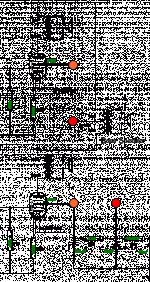Can a power amp be built with two output transformers per channel? A big one optimized for accurate bass going to the woofer, and a small one optimized for clear and sweet mids and treble going to the wide range driver.
The output from each tranny would be mostly full range so a crossover circuit on the speaker would still be required. I am not seeing this as any kind of biamping solution, only an optimization.
The output from each tranny would be mostly full range so a crossover circuit on the speaker would still be required. I am not seeing this as any kind of biamping solution, only an optimization.
Actually Doede Douma has something just like that...
http://dddac.de
Well almost ..it is one transformer with 2 secondaries...1 for bass 1 for treble with silver wire..
http://dddac.de
Well almost ..it is one transformer with 2 secondaries...1 for bass 1 for treble with silver wire..
Hi John,
Got the EY81's and topcaps today! Thank you very much!
Here is the link to the transformer page...on Wil's bifilar windings..one with silver wire and one with copper...so not really with 2 secondaries... but nevertheless an intersting concept..
http://www.dddac.de/tp05.htm
I don't understand why you would want the dual primaries? Could you elaborate...?
Cheers,
Bas
Got the EY81's and topcaps today! Thank you very much!
Here is the link to the transformer page...on Wil's bifilar windings..one with silver wire and one with copper...so not really with 2 secondaries... but nevertheless an intersting concept..
http://www.dddac.de/tp05.htm
I don't understand why you would want the dual primaries? Could you elaborate...?
Cheers,
Bas
The international man of mystery...
Hi Bas,
Glad they got there! International post can be a bit dodgy.
Doede's 2 Headed dragon:
Interesting concept. I'll have to have a think about what's happening. It's not clear from the pictures, what the winding detail is, but I have some suspicions.
Dual primaries (this principle is for SE, but could be adapted to PP):
I meant 2 transformers: One for HF with low inductance and low capacitance.
The other for LF with High inductance and high capacitance.
In series:
The HF primary is low impedance to LF,
The LF primary is low impedance to HF.
Both transformers get what they want out of life
By putting the HF transformer nearest to the anode we ensure that the HF is not lost to ground through the LF transformers primary to secondary capacitance.
Just an idea....
Cheers,
Hi Bas,
Glad they got there! International post can be a bit dodgy.

Doede's 2 Headed dragon:
Interesting concept. I'll have to have a think about what's happening. It's not clear from the pictures, what the winding detail is, but I have some suspicions.
Dual primaries (this principle is for SE, but could be adapted to PP):
I meant 2 transformers: One for HF with low inductance and low capacitance.
The other for LF with High inductance and high capacitance.
In series:
The HF primary is low impedance to LF,
The LF primary is low impedance to HF.
Both transformers get what they want out of life
By putting the HF transformer nearest to the anode we ensure that the HF is not lost to ground through the LF transformers primary to secondary capacitance.
Just an idea....
Cheers,
Re: The international man of mystery...
the two primaries in series will form a voltage divider based on the inductance in parallel with the loads, with a perfectly linear inductance and a resistive load it could be worked out, but in real life i suspect you will get a mess... (that might just sound great)
dave
dhaen said:In series:
The HF primary is low impedance to LF,
The LF primary is low impedance to HF.
Both transformers get what they want out of life
Cheers, [/B]
the two primaries in series will form a voltage divider based on the inductance in parallel with the loads, with a perfectly linear inductance and a resistive load it could be worked out, but in real life i suspect you will get a mess... (that might just sound great)
dave
KIDS' DREAM.
Hi,
Yes...a big mess...unless...:
You parrotfeed each OPT...well that's how I dreamt it up anyway..
Pfffffttttttttttt,
Hi,
the two primaries in series will form a voltage divider based on the inductance in parallel with the loads, with a perfectly linear inductance and a resistive load it could be worked out, but in real life i suspect you will get a mess... (that might just sound great)
Yes...a big mess...unless...:
You parrotfeed each OPT...well that's how I dreamt it up anyway..

Pfffffttttttttttt,
A top-end-only transformer might be a good thing for a biamped or triamped system. Less turns for less capacitance as someone already said, and maybe the option of fancier core material seeing you arent struggling for inductance at low frequencies. It would be small too so not very expensive. Much easier to diy one too.
Attachments
I started another thread http://www.diyaudio.com/forums/showthread.php?s=&threadid=5655 which involved 2 OPTs -- not in the same manner thou -- in a single channel.
I also have seen a number of inexpensive stereo amps which introduced a 3rd transformer which was used to drive a bass speaker, (snippet of the circuit trace below). I am still not completely comfortable with my understanding of what is happening here althou i have my suspicions. What happens if you leave off the bass speaker or leave out the big OPT completely?
There was also a Crowhurst schematic published in a recent audioXpress that used dual OPTs -- it has me completely baffled.
dave
I also have seen a number of inexpensive stereo amps which introduced a 3rd transformer which was used to drive a bass speaker, (snippet of the circuit trace below). I am still not completely comfortable with my understanding of what is happening here althou i have my suspicions. What happens if you leave off the bass speaker or leave out the big OPT completely?
There was also a Crowhurst schematic published in a recent audioXpress that used dual OPTs -- it has me completely baffled.
dave
Attachments
Hi,
Even to the point of destroying the OPT when signal is present...
Much easier to build another set of amps and use the passive filtering at the input, I reckon.
Cheers,
And yes, it all falls apart if you disconnect the big speaker.
Even to the point of destroying the OPT when signal is present...
Much easier to build another set of amps and use the passive filtering at the input, I reckon.
Cheers,
Even to the point of destroying the OPT when signal is present...
Thanx.
OK. I'll either leave it out if i ever rebuild it... make sure there is a bass speaker, or add another couple tubes and use it as a separate summed bass channel.
This one isn't high in the queue, but i was curious about it so had traced the circuit (i have learned much by doing this)
dave
ok guys u mention a transformer with separate windings for lf and hf, how about 2 transformers connected in serial or parallel. Output impedance should be higher in serial i think double and half when in parallel rite. This way we can use small output trans for higher output wattage. Small output trans should have better hf response compared to its 1 single opt of the same wattage of the 2 connected together. I think parrallel is the one where the wattage is double, i thinking of using it. Am i going in the right way? looking at the 12ese they have multiple connections for different impedance ratio 10000,5000,2000 i think but only 80ma dc current. When planning for a se with kt 88 or even 300b the current wouldn't be enough. Hence an idea of using 2 12ese connected in parrallel, their ratio would be 10000 to 8. Hence when connected parallel togehter it should be 5000 to 8 roughly rite? Please advise, i am not aiming for excellent sound just for getting my feet wet in se design but need the power hence kt88. The current should be double the capacity to 160ma. of course in real world the trans would be excatly the same resistance so real current sharing would not exist so maybe one trans might draw more current. Please advise me on this?
Sorry, late to this thread. Paul Klipsch actually designed a dual output transformer 2A3 PP amp ca. 1946. The really interesting part is that a passive crossover appears in the schematic between the 2A3's and the two output transformers. One transformer was wound to advantage for LF and the other for HF. Both transformers had an impedence of 5K.
John
John
- Status
- This old topic is closed. If you want to reopen this topic, contact a moderator using the "Report Post" button.
- Home
- Amplifiers
- Tubes / Valves
- 2 OTs per channel?



